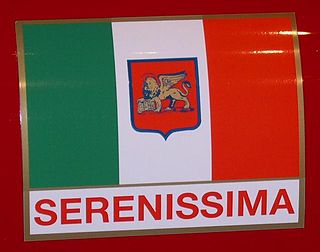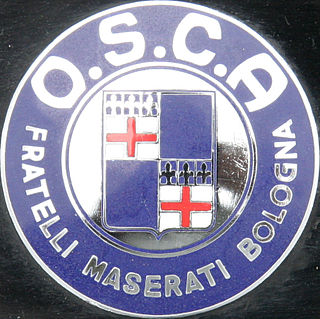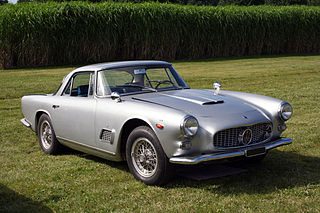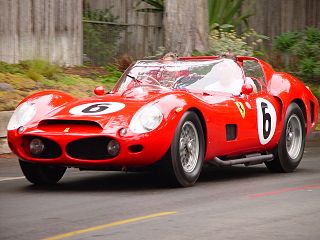
Scuderia Serenissima or Scuderia SSS Republica di Venezia was an auto racing team funded by Giovanni Volpi and active in the early 1960s. The name "Serenissima" refers to one of the many definitions the city of Venice is known for, the Volpi family being originally from the area. Based in Sasso Marconi, close to Bologna, Serenissima mostly competed in Formula One and sports car racing. Originally the team had an engine supply agreement with Ferrari. When Volpi decided to financially support ATS, a Formula One team put together by Carlo Chiti, Giotto Bizzarrini, Romolo Tavoni and other breakaway Ferrari employees, Enzo Ferrari withdrew from the agreement. Serenissima subsequently turned to De Tomaso and Maserati without much success. Serenissima officially closed in 1970.

O.S.C.A. was an Italian manufacturer of racing and sports cars established 1947 in San Lazzaro di Savena, Bologna, by the Maserati brothers, and closed down in 1967. The company name is usually written OSCA or Osca.

The Maserati 3500 GT and the Maserati 3500 GT Spyder are 2-door coupé and convertible grand tourers made by Italian car manufacturer Maserati between 1957 and 1964. It was a seminal vehicle for Maserati as the company's first successful attempt at the Gran Turismo market and series production.

Maserati 350S is a series of three racing cars made by Italian automobile manufacturer Maserati, built by Giulio Alfieri, with aluminum body design by Medardo Fantuzzi, both Maserati engineers. The 350S was built to experiment with a new straight-six engine while a V8 engine was being developed in the factory.

The Maserati 250F was a racing car made by Maserati of Italy used in '2.5 litre' Formula One racing between January 1954 and November 1960. Twenty-six examples were made.

The Maserati 450S is a racing car made by Italian automobile manufacturer Maserati for participating in FIA's endurance World Sportscar Championship racing. A total of nine were made.

Maserati A6 were a series of grand tourers, racing sports cars and single seaters made by Maserati of Italy between 1947 and 1956. They were named for Alfieri Maserati and for their straight-six engine.

Medardo Fantuzzi (1906–1986) was an Italian automotive engineer, known for his Carrozzeria Fantuzzi body workshop.

The Maserati 200S is a racing car made by Italian automobile manufacturer Maserati as a successor to the Maserati A6GCS. 28 cars were made in total. The development of the 200S, codenamed Tipo 52 started in 1952, led by Vittorio Bellentani. In response to Ferrari's 500 Mondial racing car which featured a four-cylinder engine and was quite successful in sports car racing. The car had a 1,994.3 cc (2.0 L) inline-four light-alloy engine, featuring dual overhead valves per cylinder and twin camshafts, double Weber 50DCO3 or 45DCO3 carburetors. The engine was rated at 190 PS at 7,500 rpm. Many chassis components were identical to the Maserati 150S in order to speed up development, except the rigid rear axle inherited from the Maserati A6.

The Maserati Tipo 60/61 are a series of sports racing cars produced between 1959 and 1961 by Italian automobile manufacturer Maserati for privateers racing in sports car events including the 24 Hours of Le Mans in the 2-litre and 3-litre racing category. It used an intricate tubular space frame chassis, containing about 200 chro-moly steel tubes welded together, arranged triangular formation at high stress areas of the chassis, hence the nickname "Birdcage". This method of construction provided a more rigid and, at the same time, lighter chassis than other racing cars of the time.

The Maserati A6GCM is a single seater racing car from the Italian manufacturer Maserati. Developed for Formula Two, 12 cars were built between 1951 and 1953.
Throughout its history, the Italian auto manufacturer Maserati has participated in various forms of motorsport including Formula One, sportscar racing and touring car racing, both as a works team and through private entrants. Maserati currently competes in Formula E in partnership with the Monaco Sports Group (MSG) as Maserati MSG Racing.

The Maserati 250S, and its derivative and version, the 250 Sport, are sports racing cars, designed, developed and built by Italian car manufacturer Maserati, between 1954 and 1957. Only two models were produced.

The Maserati Tipo 26 was a model of Grand Prix racing car and was the first car built by Italian manufacturer Maserati, for a total of 11 examples, between 1926 and 1932.

The Maserati Tipo 26B or Maserati Tipo 26B Monoposto was a racing car built by Italian manufacturer Maserati between 1927 and 1930, in a total of six examples and one additional engine.

The Ferrari 330 TRI/LM Spyder is a unique racing sports car purpose-built in 1962 by Ferrari to achieve victory at the 24 Hours of Le Mans. It was the last Ferrari racing sports car with a front-mounted engine and the last of a series of Ferrari race cars known as the Testa Rossas. The "I" in its designation indicates that the car has an independent rear suspension.

The Maserati 150 GT was a prototype sports car produced by Maserati in 1957. Derived from the four-cylinder Maserati 150S race car, it was a singular road-going example, and was given spyder bodywork.
Maserati has made three inline-4 racing engines, that were designed for both Formula One and Sports car racing. Their first engine was the supercharged 4CLT engine in 1950; with the 1.5 L engine configuration imposed by the FIA for engines with forced induction. Their second engine was the naturally-aspirated 250S engine; with the 2.5 L engine configuration, and was used by Cooper and JBW. Their third and final engine was the naturally-aspirated Tipo 6-1500; with the 1.5 L engine configuration, and the customer engine was used by Cooper, Emeryson, Lotus, and E.N.B. teams.
Maserati made two naturally-aspirated, straight-6, racing engines, designed for Formula One; between 1952 and 1960. The first engine was the 2.0-liter A6G; in accordance with the engine regulations imposed by the FIA. Their second and last engine was the 250 F1; in accordance with the engine regulations imposed by the FIA for 1954. Several of these engines, or derivatives of these engines, were also used in various Maserati sports cars.

The OSCA MT4, also spelled the O.S.C.A. MT4 or Osca MT4, is an Italian sports car prototype, designed, developed, and made by Officine Specializzata Costruzioni Automobili, between 1948 and 1956, but was raced and used in active competition until 1966.


















